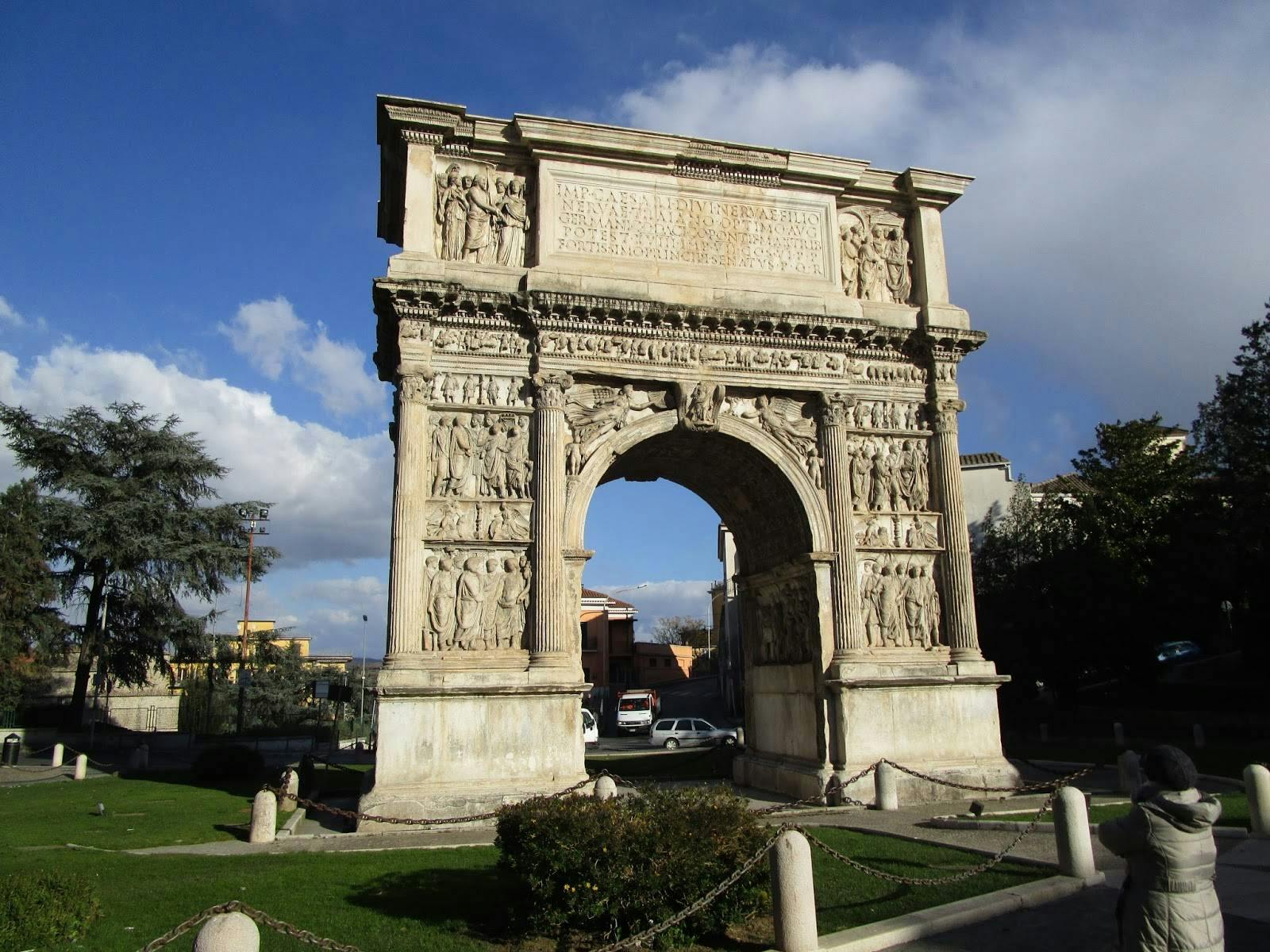Magical Benevento

nguento 'nguento, send me to the walnut tree of Benevento,
under the water and under the wind,
under all bad weather.— Matteuccia da Todi, from confessions under torture, 1428
The walnut tree of Benevento (or the nocio 'e Beneviente in local dialect) was an immense walnut tree where the *Witches' Sabbath were celebrated.
A tree sacred to Jupiter, holder of healing powers that could become harmful poisons. For their shape, which resembles externally the testicles and internally the brain, its fruits were associated with magical properties.
There are several hypotheses for the real position of the Ripa delle Janare, that is the bank on the river Sabato where the walnut tree was located, one of these wants it at a gorge called Stretto di Barba, near Ceppaloni, on the borders between Benevento and Avellino. According to others, it was found in the current area of Santa Colomba or Piano delle Cappelle.
The origins of the myth are lost in the tumultuous events of the city and collide with the work of conversion of the Lombards to Christianity between Isis, Odin and the Janare.
The city of the Goddess Isis
Goddess of many faculties, honor of the female sex.
Lovely, who makes sweetness reign in the assemblies,
enemy of hate.
You reign in the Sublime and in the Infinite.
You easily triumph over despots with your loyal advice.
It is you who, alone, found your brother (Osiris),
that you steered the boat well, and gave him
a burial worthy of him.
You want women to join men.
You are the Lady of the Earth
You made the power of women equal to that of men!— Papyrus of Oxyrinus nº 1380,
The Egyptian obelisks testify the persistence of a temple of the Goddess Isis erected by Domitian around 88 AD.
The Egyptologist Hans Wolfgang Müller, cataloging the Egyptian remains found in Benevento, proclaimed it like Rome as the largest center of Egyptian finds outside the World.
In the Isis and Osiris myth it is said that the Goddess Rich in Mysteries, divinity of love and fertility, was the daughter of Heaven and Earth, sister of Seth and of Osiris, whom she loved since they were in the womb and with whom they civilized the world as Pharaons.
Seized by jealousy Seth killed his brother Osiris locking him in a sarcophagus thrown into the Nile which was then found in the city of Byblos on the coast of Lebanon.
In search of her husband/brother, Isis, under mortal guise, came to the city gaining the trust of the queen Nemano. Found by the queen as she was putting the infant prince on a burning brazier, Isis was forced to reveal her divine nature and the meaning of that rite that was made to guarantee his immortality.
She was given the sarcophagus of Osiris and in a vain attempt to resurrect him, she became pregnant of her brother generating Horus.
Seth found Osiris and this time he cut his bother's body into pieces and scattered them across Egypt then he locked up her sister. But Isis was freed by the seven scorpio goddesses and together they left as a storm to search for the remains of Osiris who she recomposed mummifying his body to resurrect him and live forever with him ruling in the Underworld.
This myth highlights the magical aspects of the Goddess, linked to immortality and the resurrection of the dead.
The Ptolemaic dynasty also celebrate her as the protector of sailors. Her cult spread throughout the Hellenistic world reaching Rome where it quickly flourished, especially among Roman women, with the arrival of Cleopatra and Caesar who built several temples for her.
In Rome, the attributes of Isis were assimilated to those of Cybele, Demeter and Ceres.
The temple of Isis in Pompeii can still be admired today. In these numerous temples erected in her honor, the faithful could enter and pray, and a large number of priests and priestesses spread the cult through an active preaching that was later imitated by Christianity.
The christians also imitated its iconography to represent the image of the Virgin Mary, in particular the one with Jesus/Horus as a child in her arms.
The cult continued until the 6th century, when it publicly cease under the pressure of Christian preachers, who were especially avderse to the magical cult of the Goddess expressed in her threefold aspect which connects Isis to Hecate and Diana.
The temple of Isis in Benevento was probably destroyed during the barbarian invasions, but the Isiac cult may have clandestinely survived.
San Pietro and San Gennaro
The legend tells that it was Saint Peter himself who sent to Benevento San Fotino (from the Greek Pohteinos which means enlightened) as first bishop of the city.
But the most famous bishop of the city surely was San Gennaro, and some traditions attest that the patron saint of Naples was also born in Benevento.
Odin and the Witches
The coexistence of different cults passed peacefully until 663 AD, when the bishop San Barbato, whose relics are preserved in the Cathedral of Benevento, converted the Lombards by convincing them that the threat of Byzantine troops of Constant II were a divine punishment for their pagan cults.
The special adversion towards the Isiac cult came from the incestuous character of the Goddess Isis (sister and wife of Osiris), from her being a magician and an healer and from the similarities with Odin, Norse divinity imported by the Lombards.
The Lombards in fact worshiped a golden viper connected with their god Wothan (Odin). The viper, often winged, resembled the caduceus of Mercury, deity to which he was associated, and it is also plausible that they associated to him Isis too as dominatrix of snakes.
Another element that brings Isis closer to Odin is his being, like Osiris, a psychopomp, a ferryman of souls in the bardo from life to death.
Associated with the witches' sabbath was instead the rite that the Lombard knights used to perform around a walnut tree hitting, amidst their inciting womens, a goat skin slicing it in shreds to celebrate Odin, who was sacrificed and torn to pieces, as was Osiris, and thenconsumed in the Eucharist by the faithful in order to rejoin to the Mother Earth.
This myth echoes that of Yggdrasill, the cosmic tree of Norse mythology, whose name means gallows of Yggr (another name of Óðinn), as the god hung there for nine days and nine nights, pierced by a spear, sacrificing "himself to himself" to attain an higher knowledge.
The Janare
Healers and experts in medicinal herbs were also the Dianare, priestesses of Diana, the Roman goddess of the Moon.
Other traditions trace the meaning of the word back to ianua, the door on which a broom or grains of salt where placed in order to block the passage to the witches, especially in the stables, in order to prevent them from kidnapping the young mares that they brought back exhausted with the braids on the mane. The Janare were also considered experts in narcotic herbs and other magical ointments, and in all sort of wickedness.
The sorghum broom was also used for flying, one of their favorite place for taking off was the janare bridge, which was destroyed with the Allied bombings of the Second World War.
In the Samnium area there are several legends related to witches, one of these wants them cause of the mysterious appearance of physical deformities in children, of which it is said that "'a janara ll'è passato dinto 'u trepète" (the Janara put him in the tripod) where 'u trepète is the tripod of the fireside, a gesture that echoes the rite performed by Isis on the son of Queen Nemano.
It is therefore plausible that all these hateful aspects of the Janare were the result of San Barbato's efforts to erase from the memories the power that Isis gave to women and that made them equal to men.
But the Janare are not the only witches of Benevento.
The Zucculara is a limping witch who haunts the Triggio district. You too, walking around the walls of the Roman Theater at night, could hear the echo the limping step of Hecate who wanders the trivii with only one hoof.
The Manalonga is the long-handed witch of San Lupo, who drags her victims in the pits.
San Bernardino da Siena, very merciful to sinners, mentions several times in his sermons the witches of Benevento, accusing them of all wickedness.
In 1486, among the first texts printed with the new Gutenberg invention, there was the manual of the perfect ecclesiastical torturer, the Malleus Maleficarum. With this book it was easier to extort the formula used to reach the Walnut three of Benevento from the unfortunate ones accused of witchcraft.
For further information (in italian): Immersivita.it - The Janara, the Walnut three of Benevento and the other Witches


